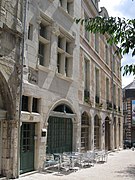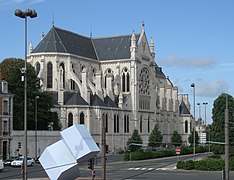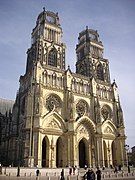Orléans
Orléans | |
|---|---|
Top to bottom, left to right: Rue Jeanne d'Arc and theSainte-Croix Cathedral,place du Martroi, the equestrian statue of Joan of Arc, bridge George-V | |
| Motto: | |
| Coordinates:47°54′09″N1°54′32″E/ 47.9025°N 1.9090°E | |
| Country | France |
| Region | Centre-Val de Loire |
| Department | Loiret |
| Arrondissement | Orléans |
| Canton | Orléans-1,2,3and4andLa Ferté-Saint-Aubin |
| Intercommunality | Orléans Métropole |
| Government | |
| • Mayor(2020–2026) | Serge Grouard[1](LR) |
| Area 1 | 27.5 km2(10.6 sq mi) |
| • Urban (2020) | 289.5 km2(111.8 sq mi) |
| • Metro (2020) | 3,422 km2(1,321 sq mi) |
| Population (2021)[2] | 116,617 |
| • Density | 4,200/km2(11,000/sq mi) |
| •Urban (2020[3]) | 285,926 |
| • Urban density | 990/km2(2,600/sq mi) |
| •Metro (2020[4]) | 454,208 |
| • Metro density | 130/km2(340/sq mi) |
| Demonym | Orléanais |
| Time zone | UTC+01:00(CET) |
| • Summer (DST) | UTC+02:00(CEST) |
| INSEE/Postal code | 45234/45000 |
| Elevation | 90–124 m (295–407 ft) (avg. 116 m or 381 ft) |
| Website | www |
| 1French Land Register data, which excludes lakes, ponds, glaciers > 1 km2(0.386 sq mi or 247 acres) and river estuaries. | |
Orléans(UK:/ɔːrˈliːənz,ˈɔːrliənz/;[5][6]US:/ˌɔːrleɪˈɒ̃,ˌɔːrliˈɑːn,ɔːrˈleɪənz/,[5][6][7][8]French:[ɔʁleɑ̃]) is a city in north-central France, about 120 kilometres (74 miles) southwest ofParis.It is the prefecture of thedepartmentofLoiretand of theregionofCentre-Val de Loire.
Orléans is located on the riverLoirenestled in the heart of the Loire Valley, classified as aWorld Heritage Site,where the river curves south towards theMassif Central.In 2020, the city had 117,026 inhabitants within its municipal boundaries.[9]Orléans is the center ofOrléans Métropolethat has a population of 290,346.[10]The largermetropolitan areahas a population of 454,208, the 20th largest in France.[4]
The city owes its development fromantiquityto the commercial exchanges resulting from the river. An important river trade port, it was the headquarters of the community of merchants frequenting the Loire. It was the capital of theKingdom of Franceduring theMerovingian periodand played an important role in theHundred Years' War,particularly known for the role ofJoan of Arcduring thesiege of Orléans.Every first week of May since 1432, the city pays homage to the"Maid of Orléans"during the Johannic Holidays which has been listed in the inventory ofintangible cultural heritage in France.One ofEurope's oldest universitieswas created in 1306 byPope Clement Vand re-founded in 1966 as theUniversity of Orléans,hosting more than 20,000 students in 2019.[11]
TheÎle d'Orléansin Quebec, Canada, takes its name from Orléans, as doOrléans, Ontarioand the city ofNew Orleans,Louisiana.
Geography[edit]

Orléans is located in the northern bend of the Loire, which crosses from east to west. Orléans belongs to thevallée de la Loiresector betweenSully-sur-LoireandChalonnes-sur-Loire,which was in 2000 inscribed byUNESCOas aWorld Heritage Site.The capital ofOrléanais,120 kilometres southwest of Paris, is bordered to the north by theBeauceregion, more specifically theOrléans Forest(French:forêt d'Orléans) and Orléans-la-Source neighbourhood, and theSologneregion to the south.
Five bridges in the city cross the Loire: Pont de l'Europe, Pont du Maréchal Joffre (also called Pont Neuf),Pont George-V(also called Pont Royal, carrying the communetramway), Pont René-Thinat and Pont de Vierzon (rail bridge).
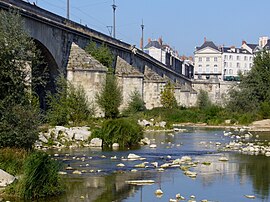
To the north of the Loire (rive droite) is to be found a small hill (102 m (335 ft) at the pont Georges-V, 110 m (360 ft) at the Place du Martroi) which gently rises to 125 m (410 ft) at la Croix Fleury, at the limits ofFleury-les-Aubrais.Conversely, the south (on therive gauche) has a gentledepressionto about 95 m (312 ft)above sea level(at Saint-Marceau) between the Loire and the Loiret, designated a "zone inondable" (flood-risk zone).
At the end of the 1960s, theOrléans-la-Sourceneighbourhood was created, 12 kilometres (7 mi)to the south of the original commune and separated from it by the Val d'Orléans and the riverLoiret(whose source is in theParc Floral de la Source). This quarter's altitude varies from about 100 to 110 m (330 to 360 ft).
Climate[edit]
Orléans experiences anoceanic climate(Köppen climate classificationCfb), similar to much of central France. July, the warmest month, has an average temperature of 19.4 °C (66.9 °F) and a high of 25.4 °C (77.7 °F), while January, the coldest month, has an average temperature of 3.9 °C (39.0 °F) and an average low temperature of 1.1 °C (34.0 °F), although February has a lower average low than January at 0.9 °C (33.6 °F). The record high temperature is 41.3 °C (106.3 °F) recorded in July, while the record low temperature of −19.8 °C (−3.6 °F) was recorded in January.
Precipitation is evenly distributed year-round, with Orléans receiving 642.5 millimetres (25.30 in) of precipitation annually. However, some months are slightly wetter than others, with the driest month receiving 44.4 millimetres (1.75 in) of rain and the wettest receiving 64.4 millimetres (2.54 in) of precipitation on average. Precipitation days vary more, with less of them in the summer months than in the other seasons. Humidity is high year-round but decreases slightly in summer. July and August only have their humidity at 72% but December has 90% humidity on average. Orléans receives 1,767.3 hours of sunshine annually, with summer being the sunniest season and winter being the least sunny season. August, receiving 224.6 hours of sunshine on average, is the sunniest month, and December, receiving 56.6 hours of sunshine on average, has the least amount of sunshine.
| Climate data for Orléans, elevation: 123 m (404 ft), 1991–2020 normals, extremes 1938–present | |||||||||||||
|---|---|---|---|---|---|---|---|---|---|---|---|---|---|
| Month | Jan | Feb | Mar | Apr | May | Jun | Jul | Aug | Sep | Oct | Nov | Dec | Year |
| Record high °C (°F) | 16.6 (61.9) |
21.9 (71.4) |
26.5 (79.7) |
29.8 (85.6) |
32.7 (90.9) |
37.9 (100.2) |
41.3 (106.3) |
39.9 (103.8) |
35.0 (95.0) |
30.1 (86.2) |
21.8 (71.2) |
18.6 (65.5) |
41.3 (106.3) |
| Mean daily maximum °C (°F) | 7.1 (44.8) |
8.5 (47.3) |
12.6 (54.7) |
16.0 (60.8) |
19.6 (67.3) |
23.1 (73.6) |
25.8 (78.4) |
25.8 (78.4) |
21.7 (71.1) |
16.5 (61.7) |
10.9 (51.6) |
7.5 (45.5) |
16.3 (61.3) |
| Daily mean °C (°F) | 4.4 (39.9) |
4.9 (40.8) |
7.9 (46.2) |
10.6 (51.1) |
14.2 (57.6) |
17.5 (63.5) |
19.7 (67.5) |
19.7 (67.5) |
16.1 (61.0) |
12.4 (54.3) |
7.7 (45.9) |
4.8 (40.6) |
11.7 (53.1) |
| Mean daily minimum °C (°F) | 1.7 (35.1) |
1.3 (34.3) |
3.3 (37.9) |
5.2 (41.4) |
8.8 (47.8) |
11.8 (53.2) |
13.6 (56.5) |
13.6 (56.5) |
10.5 (50.9) |
8.2 (46.8) |
4.5 (40.1) |
2.1 (35.8) |
7.0 (44.6) |
| Record low °C (°F) | −19.8 (−3.6) |
−16.4 (2.5) |
−12.9 (8.8) |
−5.4 (22.3) |
−3.0 (26.6) |
0.8 (33.4) |
3.7 (38.7) |
4.2 (39.6) |
−0.8 (30.6) |
−4.5 (23.9) |
−15.3 (4.5) |
−16.5 (2.3) |
−19.8 (−3.6) |
| Averageprecipitationmm (inches) | 48.1 (1.89) |
44.9 (1.77) |
44.2 (1.74) |
47.2 (1.86) |
63.0 (2.48) |
51.0 (2.01) |
57.2 (2.25) |
50.5 (1.99) |
51.3 (2.02) |
59.3 (2.33) |
60.3 (2.37) |
58.5 (2.30) |
635.5 (25.02) |
| Average precipitation days(≥ 1.0 mm) | 10.4 | 9.7 | 8.8 | 9.1 | 10.0 | 8.0 | 7.3 | 6.8 | 7.7 | 9.8 | 10.8 | 11.1 | 109.4 |
| Averagerelative humidity(%) | 89 | 85 | 79 | 74 | 76 | 74 | 72 | 72 | 77 | 84 | 89 | 90 | 80 |
| Mean monthlysunshine hours | 64.1 | 90.9 | 146.1 | 185.8 | 214.7 | 220.1 | 232.0 | 228.5 | 184.5 | 121.4 | 73.8 | 60.9 | 1,822.6 |
| Source 1:Meteo France[12][13] | |||||||||||||
| Source 2: Infoclimat.fr (relative humidity 1961–1990)[14] | |||||||||||||
[edit]
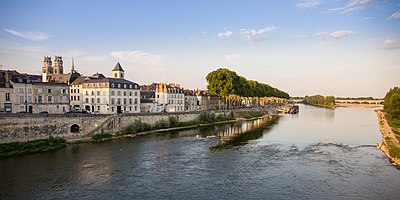
In Orléans, the Loire is separated by a submergeddikeknown as thedhuisinto theGrande Loireto the north, no longer navigable, and thePetite Loireto the south. This dike is just one part of a vast system of construction that previously allowed the Loire to remain navigable to this point.
The Loire was formerly an important navigation and trading route, and is at the heart of the city's foundation in the second century BC as a center of trade oremporium.[15]More recently, during the 17th century, the river enabled Orleans to become a major hub for refining sugar, which was imported from the Caribbean viaNantes,and whose commerce boosted other aspects of the local economy, such as sweets, chocolate manufacturing, and paper for wrapping.[16]In the 18th century, Orleans also acquired a reputation for producing vinegar, from local vineyards as well as wine traveling up the Loire.[17]
With the increase in size of ocean-going ships, large ships can now navigate theestuaryonly up to aboutNantes.

Boats on the river were traditionally flat-bottomed boats, with large but foldable masts so the sails could gather wind from above the river banks, but the masts could be lowered in order to allow the boats to pass under bridges. These vessels are known as "gabarre", "futreau",and so on, and may be viewed by tourists near pont Royal.
The river's irregular flow strongly limits traffic on it, in particular at its ascent, though this can be overcome by boats being given a tow.
AnInexplosible-typepaddle steamerowned by the mairie was put in place in August 2007, facing Place de la Loire and containing a bar.
Every two years, the Festival de Loire recalls the role played by the river in the commune's history.
On the river's north bank, near the town centre, is theCanal d'Orléans,which connects to theCanal du Loingand theCanal de BriareatBugesnearMontargis.The canal is no longer used along its whole length. Its route within Orléans runs parallel to the river, separated from it by a wall ormuret,with a promenade along the top. Its lastpoundwas transformed into an outdoor swimming pool in the 1960s, then filled in. It was reopened in 2007 for the "fêtes de Loire." There are plans to revive use of the canal for recreation and install a pleasure-boat port there.
History[edit]
Prehistory and Roman Empire[edit]
- See alsoCenabum,Aureliana Civitas.
Cenabumwas aGaulstronghold, one of the principal towns of the tribe of theCarnuteswhere theDruidsheld their annual assembly. TheCarnuteswere massacred and the city was destroyed byJulius Caesarin 52 BC.[18]In the late 3rd century AD,Roman EmperorAurelianrebuilt the city and renamed itcivitas Aurelianorum( "city of Aurelian" ) after himself.[19]The name later evolved into Orléans.[20]
In 442 Flavius Aetius, the Roman commander in Gaul, requestedGoar,head of theIraniantribe ofAlansin the region to come to Orleans and control the rebellious natives and the Visigoths. Accompanying theVandals,the Alans crossed the Loire in 408. One of their groups, underGoar,joined the Roman forces ofFlavius Aetiusto fightAttilawhen he invaded Gaul in 451, taking part in theBattle of Châlonsunder their kingSangiban.Goar established his capital in Orléans. His successors later took possession of the estates in the region between Orléans and Paris. Installed in Orléans and along the Loire, they were unruly (killing the town's senators when they felt they had been paid too slowly or too little) and resented by the local inhabitants. Many inhabitants around the present city have names bearing witness to the Alan presence – Allaines. Also many places in the region bear names of Alan origin.[21]
Early Middle Ages[edit]
In theMerovingianera, the city was capital of the Kingdom of Orléans followingClovis I's division of the kingdom, then under theCapetiansit became the capital of acountythenduchyheld inappanageby the house of Valois-Orléans. The Valois-Orléans family later acceded to the throne of France viaLouis XII,thenFrancis I.In 1108,Louis VI of Francebecame one of the few French monarchs to be crowned outside ofReimswhen he was crowned inOrléans cathedralbyDaimbert, Archbishop of Sens.
High Middle Ages[edit]


The city was always a strategic point on the Loire, for it was sited at the river's most northerly point, and thus its closest point to Paris. There were few bridges over the dangerous riverLoire,but Orléans had one of them, and so became – withRouenand Paris – one of medieval France's three richest cities.
On the south bank the "châteletdes Tourelles "protected access to the bridge. This was the site of thebattleon 8 May 1429 which allowedJoan of Arcto enter and lift the siege of thePlantagenetsduring theHundred Years' War,with the help of the royal generalsDunoisandFlorent d'Illiers.The city's inhabitants have continued to remain faithful and grateful to her to this day, calling her "la pucelle d'Orléans" (the maid of Orléans), offering her a middle-class house in the city, and contributing to her ransom when she was taken prisoner.

1453 to 1699[edit]

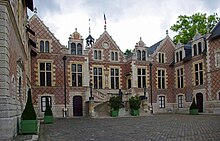
Once theHundred Years' Warwas over, the city recovered its former prosperity. The bridge brought in tolls and taxes, as did the merchants passing through the city. KingLouis XIalso greatly contributed to its prosperity, revitalising agriculture in the surrounding area (particularly the exceptionally fertile land aroundBeauce) and relaunchingsaffronfarming atPithiviers.Later, during theRenaissance,the city benefited from its becoming fashionable for richchâtelainsto travel along the Loire valley (a fashion begun by the king himself, whose royal domains included the nearby châteaus atChambord,Amboise,Blois,andChenonceau).
TheUniversity of Orléansalso contributed to the city's prestige. Specializing in law, it was highly regarded throughout Europe.John Calvinwas received and accommodated there (and wrote part of his reforming theses during his stay), and in returnHenry VIII of England(who had drawn on Calvin's work in his separation from Rome) offered to fund a scholarship at the university. Many other Protestants were sheltered by the city. Jean-Baptiste Poquelin, better known by his pseudonymMolière,also studied law at the University, but was expelled for attending a carnival contrary to university rules.
From 13 December 1560 to 31 January 1561, theFrench States-Generalafter the death ofFrancis II of France,the eldest son ofCatherine de MédicisandHenry II.He died in the Hôtel Groslot in Orléans, with his queenMaryat his side.
Thecathedralwas rebuilt several times. The present structure had its first stone laid byHenry IV,and work on it took a century. It thus is a mix of late Renaissance and earlyLouis XIVstyles, and one of the last cathedrals to be built in France.
1700–1900[edit]
When France colonised America, the territory it conquered was immense, including the wholeMississippi River(whose first European name was the RiverColbert), from its mouth to its source at the borders of Canada. Its capital was namedla Nouvelle-Orléansin honour ofLouis XV's regent, theduke of Orléans,and was settled with French inhabitants against the threat from British troops to the north-east.
The Dukes of Orléans hardly ever visited their city since, as brothers or cousins of the king, they took such a major role in court life that they could hardly ever leave. The duchy of Orléans was the largest of the French duchies, starting atArpajon,continuing toChartres,Vendôme,Blois,Vierzon,andMontargis.The duke's son bore the titleduke of Chartres.Inheritances from great families and marriage alliances allowed them to accumulate huge wealth, and one of them,Philippe Égalité,is sometimes said to have been the richest man in the world at the time. His son, KingLouis-Philippe I,inherited the Penthièvre and Condé family fortunes.
1852 saw the creation of theCompagnies ferroviaires Paris-Orléansand its famousgare d'Orsayin Paris. In theFranco-Prussian Warof 1870, the city again became strategically important thanks to its geographical position, and was occupied by thePrussianson 13 October that year. Thearmée de la Loirewas formed under the orders ofGeneral d'Aurelle de Paladinesand based itself not far from Orléans atBeauce.
1900 to present[edit]

During theSecond World War,the German army made theOrléans Fleury-les-Aubraisrailway station one of their central logistical rail hubs. The Pont Georges V was renamed "pont des Tourelles".[22]A transit camp for deportees was built atBeaune-la-Rolande.During the war, the American Air Force heavily bombed the city and the train station, causing much damage. The city was one of the first to be rebuilt after the war: the reconstruction plan and city improvement initiated by Jean Kérisel and Jean Royer was adopted as early as 1943, and work began as early as the start of 1945. This reconstruction in part identically reproduced what had been lost, such as Royale and its arcades, but also used innovative prefabrication techniques, such as îlot 4 under the direction of the architectPol Abraham.[23]
The big city of former times is today an average-sized city of 250,000 inhabitants. It is still using its strategically central position less than an hour from the French capital to attract businesses interested in reducing transport costs.
Heraldry[edit]
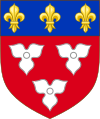
According toVictor Adolphe Malte-BruninLa France Illustrée,1882, Orléans's arms are "gules,three caillous incœurs de lysargent,and on a chiefazure,three fleurs de lysOr."Charle Grandmaison, in theDictionnaire Héraldiqueof 1861, states that it is "Or, with three hearts in gules", without the chief of France. Faulty designs sometimes describe it as "gules, three fleurs de lys argent, and on a chief azure three fleurs de lys Or."[24]
The "cœurs de lys", or heart of a lily, is not a true lily, which would have 6tepals,but a stylized or symbolic lily. Certain authors solve the problem by calling this symbol a "tiercefeuille",defined as a stemlesscloverleaf, with one leaf at the top and two below, thus making this coat of arms "gules, with three reversed tiercefeuilles in argent, etc".
Motto[edit]
"Hoc vernant lilia corde" (granted byLouis XII,thenduke of Orléans), meaning "It is by this heart that lilies flourish" or "This heart makes lilies flourish", referring to thefleur de lys,symbol of the French royal family.
Population[edit]
|
| ||||||||||||||||||||||||||||||||||||||||||||||||||||||||||||||||||||||||||||||||||||||||||||||||||||||||||||||||||
| |||||||||||||||||||||||||||||||||||||||||||||||||||||||||||||||||||||||||||||||||||||||||||||||||||||||||||||||||||
| Source: EHESS[25]and INSEE (1968-2020)[9] | |||||||||||||||||||||||||||||||||||||||||||||||||||||||||||||||||||||||||||||||||||||||||||||||||||||||||||||||||||
Transport[edit]
Public transport[edit]
TAO manages buses andtram lines in Orléans.The first tram line was inaugurated November 20, 2000 and the second line on June 30, 2012. The network contains 29.3 km of rail. The annual ridership was 18.46 million in 2022.[26]

Roads and highway[edit]
Orléans is an autoroute intersection: theA10(linking Paris toBordeaux) links to the commune outskirts, andA71(whose bridge over the Loire is outside the commune limits) begins here, heading for the Mediterranean viaClermont-Ferrand(where it becomes theA75).
- A10 HighwayFrom Paris toBordeaux
- A71 HighwayFrom Orléans toBourges
- A19 HighwayFromSenstoArtenay
- National Road 20From Paris to Spain
Railway[edit]
Orléans is served by two main railway stations: the centralGare d'Orléansand theGare des Aubrais-Orléans,in the northern suburbs. Most long-distance trains call only at the Les Aubrais-Orléans station, which offers connections to Paris, Lille, Tours, Brive-la-Gaillarde, Nevers, and several regional destinations.
People[edit]



Orléans is the birthplace of:
- Sophie Adriansen(born 1982), French writer
- Patrick Barul(born 1977), football player
- Joelly Belleka(born 1995), basketball player
- Raoul Blanchard(1877–1965), geographer
- Maxence Boitez (Ridsa) (born 1990), singer
- Patrick Bornhauser(born 1957), racing driver
- Raymond Brugère(1885-1966), diplomat.
- Jean-Baptiste Marc Bourgery(1797–1849), anatomist
- Félix Cazot(1790–1857), classical pianist and composer
- Philippe Chanlot(born 1967), football player
- Marion Cotillard(born 1975), actress, not born in Orléans, but grew up there
- Gilles Delouche(1948–2020), linguist
- Satchela Evrard Djedje (Vegedream) (born 1992), singer
- Étienne Dolet(1509–1546), scholar and printer
- Joël-François Durand(born 1954), composer
- Jean-Louis Ferrary(1948–2020), historian
- Georges Fleury(1878–1968), cyclist
- Albert Gombault(1844–1904), neurologist
- Guillaume Gomez(born 1969), racing driver
- Jacques Guillemeau(1550–1613), physician
- Albert Guyot(1881–1947), racing driver
- Étienne Hubert(1567–1614), Arabist
- Gaston d'Illiers(1876–1932), sculptor
- Isaac Jogues(1607–1646),Jesuitmissionary
- Stanislas Julien(1797–1873),orientalist
- Gustave Lanson(1857–1934), historian
- Pierre Levesville(1570–1632), Renaissance architect
- Anatole Loquin(1834–1903), writer and musicologist
- Yven Moyo(born 1992), football player
- Yves-Marie Pasquet(born 1947), composer
- Charles Péguy(1873–1914), poet and essayist
- Antoine Petit(1722–1794), physician
- Lamine Sambe(born 1989), basketball player
- Yacine Sene(born 1982), basketball player
- Florian Thauvin(born 1993), football player
- Christophe Tinseau(born 1969), racing driver
- Jean Zay(1904–1944), jurist and politician
Culture[edit]
Historical landmarks[edit]

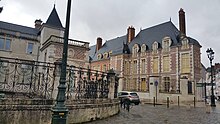
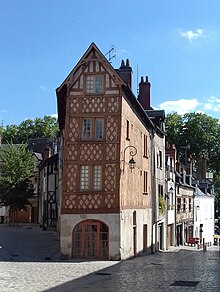
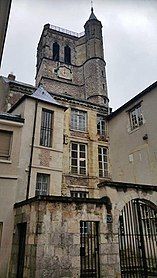


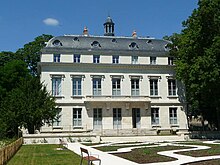
- The Gallo-Roman town-wall on the north side of the cathedral (4th century AD) and along the rue de la Tour-Neuve
- TheHôtel Groslot,built between 1550 and 1555 for Jacques Groslot, "bailli d'Orléans" by Jacques Ier Androuet du Cerceau. KingFrançois II of Francedied there in 1560. KingsCharles IX,Henri III of France andHenri IV of Francestayed there. The "Hôtel" was restored in 1850. The building became the town Hall of Orléans in 1790 (weddings are still celebrated inside).
- Thehôtel de la Vieille Intendance(early 15th century) (otherwise named hôtel Brachet, formerly "The King's house" ), real gothic-renaissance style château made of bricks.[27]Nowadays housing the Administrative Court of Orléans. One can admire its frontage from the entrance in the rue de la Bretonnerie. Yet, the building – which sheltered the highest figures of the kingdom passing by the city, and maybe some kings themselves (Henri IV, Louis XIII, Louis XIV of France) – can easily be observed from its gardens, opened to the public (entrance rue d'Alsace-Lorraine).
- Thehôtel de la Motte-Sanguin(18th century) and its gardens, manor built at the behest ofLouis-Philippe, Duke of Orléans(1747–1793), cousin of the King Louis XVI. He was surnamed "Philippe Égalité" / "equality" referring to his support to the 1789 revolutionaries. Nicknamed "the richest man on earth"he voted in favour of the death penalty against his own cousin the kingLouis XVI,and suffered the same fate himself. This is a classic style princely residence (and even royal, since Philippe Égalité's heir accessed the throne of France under the name ofLouis-Philippe Ier). It is part of a public park opened to the public (via the Solférino street).
- Theschool of artillery,next to theHôtel de la Motte-Sanguinwhich it is often confused with, formerly housing a military school, it was built in the 19th century near theLoire.[28]
- Remains of theUniversity of Orléans(a 15th-century building housing the thesis room), founded in 1306 bypope Clement V,in which, among many other great historical figures, the ProtestantJohn Calvinstudied and taught. The University was so famous that it attracted students from all over Europe, particularly Germany. The city of Orléans is one of the cradles of Protestantism.
- TheHouse of Louis XI(end of the 15th century), on Saint-Aignan square. Built at the behest of the king, who particularly reveredSaint Aignan.[29]
- TheHouse of Joan of Arc,where she stayed during thesiege of Orléans(this is actually an approximate reconstitution, the original building being bombed in 1940 during theBattle of France).
- Place du Martroi,heart of the city, with the equestrian statue ofJoan of Arcat its centre, made byDenis Foyatier.This statue was damaged during the Second World War, then repaired byPaul Belmondo,father of the famous 1950s to 1980s French actor.
- Duke of Orléans'Chancellerie(XVIIIe), located next to thePlace du Matroi,also bombed during the Second World War, only the frontage resisted.
- TheBannier gate-house,discovered in 1986 under the statue ofJoan of Arc(Place du Martroi). It was built in the 14th century. It can be seen through a window in the subterranean car-park under the square, or visited under certain conditions.
- Therue de Bourgogneand surrounding streets, Orléans' main street since the Antiquity, it's the former Roman decumanus, crossing the city from east to west.Joan of Arcentered the city in 1429 by the "Bourgogne" gatehouse situated at its Easter end. Until today it is still giving access to the "Prefecture", where the "Prefet" (officer who represents the French State in the Region) lives, many pubs, night clubs, restaurants and shops such as the "Galeries Lafayette". It is more than a mile long. One can admire many medieval houses on its sides.
- TheTour Blanche / White Tower,it is one of the only medieval defensive towers remaining in the city (still in use at the time of thesiege of Orléans). It nowadays houses the city's archaeological department.
- The Docks,(Port of Orléans]) once the most important inland port of France (18th century). While boats could not sail on the river Seine because of the windings, they could sail to Orléans on the river Loire with the wind in their back. Then the merchandise was brought to Paris by roadways. Wine, and sugar from the colonies, were shipped to Orléans where they were stored and refined. Vinegar is still a city speciality due to the lapsing of wine stocks during the shipment. One can admire the old pavement of the docks (18th and 19th centuries) on the north bank of the river in the city and on the island in the middle, that was used to channel the water
- TheHôpital Madeleine(former hospital), built byKing Louis XIV(18th century) and his successors (notably an important part of the 18th century).
- Saint-Charleschapel, located within the grounds of the Madeleine Hospital, it was built in 1713 by Jacques V Gabriel, one of Louis XIV's architects.
- TheHôtel Cabu,otherwise namedhouse of Diane de Poitiers,built at the behest of Philippe Cabu, barrister, in 1547, famous architect Jacques Ier Androuet du Cerceau providing the plans.
- TheHôtel Hatte,16th century. Today's Charles-Péguy Center.
- TheHôtel Toutin,16th century
- TheHôtel Pommeret d'Orléans,16th century
- TheHôtel Ducerceau,16th century
- Themaison de la coquille,16th century
- TheHôtel des Créneaux,former city hall, flanked by its bell tower (15th century). It nowadays houses the city's school of music. This is a magnificent piece of late gothic secular architecture (15th century) that calls to mind the famous and much more recent Parisian city hall.
- TheHouse of Jean Dalibert,16th century
- TheStudy of Jacques Bouchet(16th century), which can be admired from the public square "Jacques Bouchet"
- The mansions, rue d'Escure (17th and 18th centuries)
- The "Préfecture": former Benedictine monastery, built in 1670 and housing the "Préfecture du Loiret" since 1800.
- ThePont de l'Europe,designed bySantiago Calatrava,is an inclined bow-string ark bridge particularly original.
- ThePont Royal/ George V Royal bridge,the oldest bridge of the city. Built between 1751 and 1760, at the request ofDaniel-Charles Trudaine,administrator and civil engineer. It was renamed in honour ofKing George Vafter theWorld War Iout of respect ofBritain's role in the war.
- ThePont des Tourelles,built in 1140 and demolished in 1760, was the first stone-made bridge of Orléans. When the river Loire is low, one can see remains of it in the water
- ThePalais épiscopal d'Orléans,former Bishop's Palace. It was built between 1635 and 1641.Napoléonstayed there. It is nowadays housing the international centre for research, part ofUniversity of Orléans.
- The courthouse (18th to 20th centuries)
- The "salle de l'Institut",located on the" place Sainte Croix ", is a small concert hall which can be converted into a ballroom. Its acoustics are remarkable.
- Mansions, rue de la Bretonnerie.This street concentrates many particular mansions, of all styles and ages (15th to 20th centuries). High society members, politicians, barristers, doctors... continue to live there.
- Mansions, rue d'Alsace-Lorraine,19th-century bourgeoisie style houses.
- StatueLa Baigneuseby Paul Belmondo, aside the rue Royale (1955).
- Statue of Calvin, by Daniel Leclercq, facing the Calvinist temple (2009).[30]
- TheFRAC Centrebuilding named "Les turbulences", an advanced piece of architecture covered with L.E.Ds.
- Memorial Museum to the Children of Vel d'Hiv at theCentre d'étude et de recherche sur les camps d'internement du Loiret(Study and Research Centre on the Internment Camps in Loiret), commemorating over 4,000 Jewish children who were concentrated at theVélodrome d´Hivercycling arena in Paris in July 1942, after which they were interned at eitherPithiviersorBeaune-la-Rolande,and eventually deported to theAuschwitz extermination camp.[31]
- Many historical houses and mansions (hundreds) can still be admired in the city centre, which is one of the largest in France due to the great importance of the city until the 20th century. The historical centre dating back to the 15th century extends far beyond the limits of the pedestrian sector that has been extensively restored in the past few years. In fact it corresponds to the portion of the modern city which is enclosed by the Boulevards. Many historical monuments remain in the non-pedestrian sectors of the city (for example, at rue Notre-Dame-de-Recouvrance, at rue des Carmes, at rue de la Bretonnerie, at Square Saint-Aignan).
Museums[edit]
Museums in Orléans:[32]
- Musée des Beaux-Arts d'Orléans
- Charles PeguyCentre
- Joan of Arc's House
- Fine Arts Museum
- City Historical and Archeological Museum
- Natural Science Museum
Parks[edit]
Parks in Orléans:[33]
- Parc Floral de la Source
- Motte Sanguin garden
- Charpenterie garden
- Botanic garden
- Anjorrant park
- Charbonnière park
- Moins Roux park
- Pasteurpark
Media[edit]
- TV network:Orléans TV
- Newspaper:La République du CentreArchived26 June 2011 at theWayback Machine(the Republic of the Centre)
- Radio station:Radio Campus Orléans88.3 FM
Music[edit]
- Annual week-long classical music festival Semaines musicales internationales d'Orléans, founded in 1968.[34]
- Burning Heads
Sport[edit]
Orléans has abasketballteam:Orléans Loiret Basketwhich is in theFrench first division.The club won the "Coupe de France" of basketball, its first major trophy, in the season 2009 – 2010.
Orléans also has afootballclub, theUS Orléans,which plays inChampionnat National.
There is also a semi-professional rugby team,RC Orléans.
The city also has very well known clubs inkarate,fencingandjudo.
In 2012, Orléans hosted a stage finish ofParis–Nice.
Twin towns – sister cities[edit]
 Dundee,United Kingdom
Dundee,United Kingdom Treviso,Italy
Treviso,Italy Münster,Germany
Münster,Germany Kristiansand,Norway
Kristiansand,Norway Wichita,United States
Wichita,United States Tarragona,Spain
Tarragona,Spain Saint-Flour,France
Saint-Flour,France Utsunomiya,Japan
Utsunomiya,Japan Lugoj,Romania
Lugoj,Romania Yangzhou,China
Yangzhou,China New Orleans,United States
New Orleans,United States Kraków,Poland
Kraków,Poland Parakou,Benin
Parakou,Benin
Education[edit]
- University of Orléans:the University campus is in theLa Sourcearea in southern part of the commune.

- Polytech Orléans: Engineer school
- IUT: University Institutes of Technology
- IAE: Institut d'Administration des Entreprises
- IUP: Institut universitaire professionnalisé
- ESAD Orléans: School of Art and Design
- ESCEM: School of Business and Management
- SUPINFO: Higher education in Computer Science
- EXIA CESI: School of Industrial Engineering
Gallery[edit]
-
Campo Santo.
-
Place Sainte-Croix.
-
Hospital Madeleine.
-
The White Tower.
-
Old town.
-
Saint-Paterne.
-
Orléans Cathedral.
-
Statue of Joan of Arc.
See also[edit]
- Council of Orléans
- House of Orléans
- Orléanist
- Roman Catholic Diocese of OrléansBishopric of Orléans
- La Source, Orléans
References[edit]
- ^"Répertoire national des élus: les maires"(in French). data.gouv.fr, Plateforme ouverte des données publiques françaises. 6 June 2023.
- ^"Populations légales 2021"(in French).The National Institute of Statistics and Economic Studies.28 December 2023.
- ^"Évolution et structure de la population en 2020 − Unité urbaine 2020 d'Orléans (45701)"(in French). INSEE.Retrieved24 January2024.
- ^ab"Évolution et structure de la population en 2020 − Aire d'attraction des villes 2020 d'Orléans (025)"(in French). INSEE.Retrieved24 January2024.
- ^ab"Orleans"(US) and"Orleans".LexicoUK English Dictionary.Oxford University Press.Archived fromthe originalon 22 March 2020.
- ^ab"Orléans".Collins English Dictionary.HarperCollins.Retrieved12 April2019.
- ^"Orléans".The American Heritage Dictionary of the English Language(5th ed.). HarperCollins.Retrieved12 April2019.
- ^"Orléans".Merriam-Webster Dictionary.Retrieved12 April2019.
- ^abPopulation en historique depuis 1968,INSEE
- ^"Évolution et structure de la population en 2020 − Intercommunalité-Métropole de Orléans Métropole (244500468)"(in French). INSEE.Retrieved24 January2024.
- ^"Vérification - Il y aurait près de 20.000 étudiants à Orléans: Vrai ou faux?".6 May 2021.
- ^"Climatological Information for Besançon, France".Meteo France. 14 February 2019. Archived fromthe originalon 12 June 2018.Retrieved30 December2015.
- ^ "Orléans (45)"(PDF).Fiche Climatologique: Statistiques 1991–2020 et records(in French). Meteo France.Retrieved14 February2019.
- ^"Normes et records 1961–1990: Orléans – altitude 123m"(in French). Infoclimat.Retrieved14 February2019.
- ^"Orleans, emporium des Carnutes".Archeologie Orleans Metropole.
- ^"Les raffineries de sucre".Archives Orleans Ville et Metropole.
- ^"Le vinaigre et Orleans".Archives Orleans Ville et Metropole.
- ^"C. Julius Caesar, Gallic War, Book 7, chapter 28".perseus.tufts.edu.Retrieved16 February2018.
- ^Larousse, Éditions."Orléans - LAROUSSE".larousse.fr(in French).Retrieved28 April2021.
- ^For an exact etymology, seeCenabum, Aurelianis, Orléansde Jacques Debal (Coll. Galliae civitates, Lyon, PUL, 1996)
- ^marres.educationArchived20 May 2020 at theWayback Machine.Accessed January 2016.
- ^World-wide current events of 16 May 1941, available on the site of theINA(direct link).
- ^Joseph Abram,L'architecture moderne en France, du chaos à la croissance,tome 2, éd. Picard, 1999, pp. 28 et 37–38
- ^Grand Larousse encyclopédiquein 10 volumes, 163
- ^Des villages de Cassini aux communes d'aujourd'hui:Commune data sheet Orléans,EHESS(in French).
- ^ Rapport annuel 2022 Parc - trafic - événements d’exploitation Tramways,Service Technique des Remontées Mécaniques et des Transports Guidés, p. 8.
- ^"Tribunal administratif d'Orléans: Histoire du tribunal".Archived fromthe originalon 22 April 2014.Retrieved3 November2014.
- ^"La Motte Sanguin - Orleans.fr".Archived fromthe originalon 16 April 2015.Retrieved3 November2014.
- ^J. DEBAL, Orléans: Une Ville, Une Histoire
- ^Les Français érigent une statue de CalvinArchived6 July 2011 at theWayback Machine,sur le site Bonnenouvelle.ch.
- ^"CERCIL – Study and Research Centre on the Internment Camps in Loiret: Remembrance".Information Portal to European Sites of Remembrance.Berlin, Germany: Stiftung Denkmal für die ermordeten Juden Europas.Retrieved19 June2020.
- ^Patrice Gabin (13 October 2007)."Orléans tourisme: musées à Orléans (Orléans tourism: Museums in Orléans)".Archived fromthe originalon 13 October 2007.Retrieved6 April2011.
- ^Patrice Gabin (13 October 2007)."Park and Gardens in Orléans".Archived fromthe originalon 13 October 2007.Retrieved6 April2011.
- ^"Festivals de musique – France",Identifiants et référentials, retrieved 6 May 2018
- ^"Les villes amies".orleans-metropole.fr(in French). Orléans.Retrieved15 November2019.
Notes[edit]
- A Chronicle of The City's Office Bearers, Chambers, Regalia, Castles & Twin Cities(PDF),Dundee City Council,retrieved25 April2011
Bibliography[edit]
External links[edit]
- (in French)Orléans commune official web site
- (in French)Tourism Office
- (in French)official web site of Orléans
 This article incorporates text from a publication now in thepublic domain:Herbermann, Charles, ed. (1913). "Diocese of Orléans".Catholic Encyclopedia.New York: Robert Appleton Company.
This article incorporates text from a publication now in thepublic domain:Herbermann, Charles, ed. (1913). "Diocese of Orléans".Catholic Encyclopedia.New York: Robert Appleton Company.














